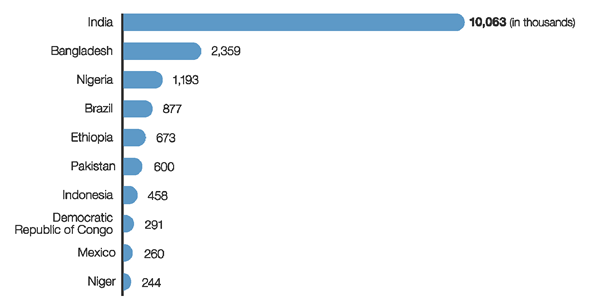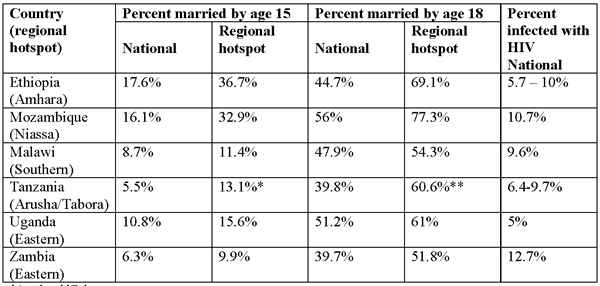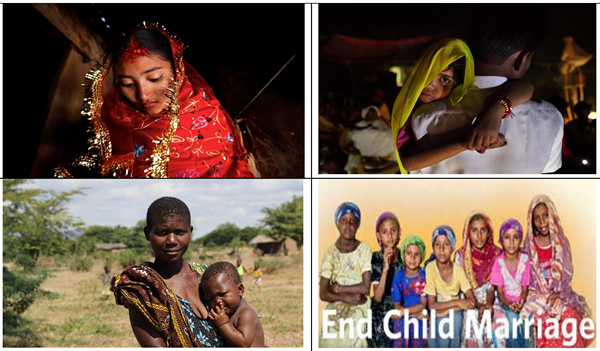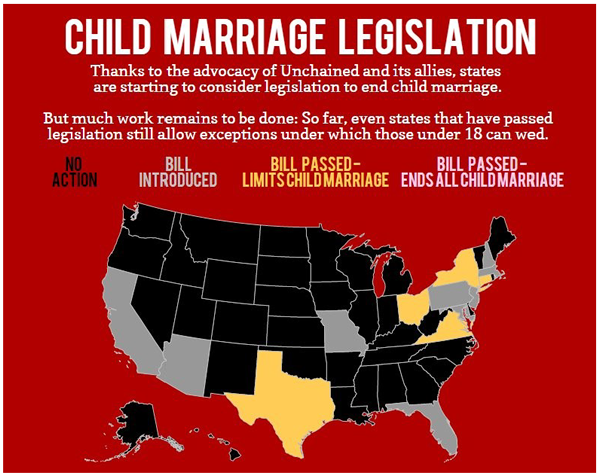结束童婚:呼吁全球行动
WHEC实践公报和临床管理准则的医疗保健提供商。教育补助金所提供妇女保健和教育中心( WHEC ) 。
Today, there are nearly 70 million child brides worldwide. Every 2 seconds a young girl is forced into marriage. Be part of the generation that changes that. This review, recommendations and practice bulletin on child marriage are an introduction to various global projects and programs, for ending child marriage, for the healthcare providers. More than 140 million girls below 18 years of age will marry between 2011 and 2020. Furthermore, of the 140 million girls who will marry before they are of 18 years; 50 million will be under the age of 15 years. If current levels of child marriages hold, 14.2 million girls annually or 39,000 will marry too young. With marriage, a girl's childhood abruptly ends. Her health and future prospects immediately fall in jeopardy. The next generation of development programs must make ending child marriage a priority. Moving forward, there must also be more investment in documentation and evaluation of what works to end child marriage - a body of successful programs to expand on. But much more work is required across geographic settings and communities. It is critical that these efforts do not overlook girls who are already married. They are among the marginalized members of society and need special attention in development programs and planning.
The purpose of this document is to discuss the issue of child marriage, implications on the communities and societies, accelerating global health agenda and achieving 2030 Sustainable Development Goals (SDGs) by ending child marriage. The silence on the plight of child brides must end. Tackling child marriage is a daunting but possible task, requiring political-will and proactive multi-faceted strategies at the international, national and regional community levels. Traditional notions of child marriage continue to justify it as a positive social norm with social and financial benefits. However, new studies on the health and social consequences reveal far more damaging results. Families, community leaders and the broader community are also essential in helping change norms and expectations about what is possible for girls and women.
Definition
Child marriage, also known as early marriage, is defined as "Any marriage carried out below the age of 18 years, before the girl is physically, physiologically, and psychologically ready to shoulder the responsibilities of marriage and childbearing." Marriage is a formalized, binding partnership between consenting adults, which sanctions sexual relations and gives legitimacy to any offspring. It is still a respected and valued social institution throughout the world and may take different forms in different cultures. In many societies in developing countries, child marriages are used to build or strengthen alliances between families. Sometimes this may even include the betrothals of young children or babies. Child marriage - marriages of under 15-years of age is more common in rural communities. This is because rural communities tend to hold on to more entrenched traditional attitudes and customs.
Child marriage remains a widely ignored violation of the health and development rights of girls and young women. Governments are often either unable to enforce existing laws or rectify discrepancies between national laws on marriage age and entrenched customary and religious laws. This is because of the "official tolerance of cultural, societal and customary norms that shape and govern the institution of marriage and family life." In general, there is seldom political-will to act when it comes to women's and girls' human rights. Child marriage is culturally packaged as a social necessity, but in many cases, this amounts to "socially licensed sexual abuse and exploitation of a child."
Prevalence and Geography of a Problem
The practice persists to varying degrees around the globe. The highest prevalence rates, commonly measured by the percentage of women aged twenty to twenty-four who report being married before 18 years, are found in South Asia and West and Central Africa, where an estimated 2 out of 5 girls are married as children. However, in terms of absolute numbers, India surpasses other countries by a wide margin: about 40% of all child marriages take place there. In 41 countries, the prevalence of child marriage is 30% or more (UNFPA). Surveys of child brides conducted by the United Nations (UN) and many non-governmental agencies paint a broad demographic portrait of young married girls:
- Girls from rural areas are twice as likely to marry as children as those from urban areas.
- Child brides are most likely to be from poor families. Across many countries, young married girls are most often from the poorest quintile of the income bracket.
- Married girls are generally less educated, either for lack of opportunity or the curtailment of their schooling by early marriage.
In some countries, disparities in the prevalence of child marriage also lie along religious, ethnic, or regional lines. For instance, in Guatemala, early marriage is most common among indigenous Mayan communities.
Top 10 Countries with Child Brides

Source: UNICEF Statistics and Monitoring Section, Division of Policy and Strategy (2017)
The Value of a Bride Economics
Poverty, cultural norms, and the low societal value of women and girls are the primary forces that fuel early marriage, although the relative significance of each varies from community to community. In communities where women are generally not considered viable wage earners, families often view daughters as an economic burden. Impoverished parents may decide to betrothal a daughter early to avoid the cost of education - if schooling is even available, parents have an extra incentive to marry off daughters sooner. Families sometimes marry off a child to erase debts or settle feuds. Dowries and bride prices also factor into timing of child marriages. In such cases, youth is seen as enhancing the value of bride; a younger girl has more time to dedicate to her new family and bear children. In many parts of India, dowries, or money given to the groom's family, can be lowered if the bride is younger. Bride prices, money given to the bride's parents (a custom in many parts of sub-Saharan Africa), rise if a bride marries at an earlier age. Low esteem girls and women facilitates these transactions involving young girls.
Health and Human Rights
Child brides are often expected to bear children soon after marriage, which makes them vulnerable to pregnancy and childbirth complications, including obstetric fistula, a condition that causes chronic incontinence and occurs commonly in young girls who give birth before their bodies have matured. The World Health Organization (WHO) reports that pregnancy complications remain the leading cause of death among girls aged 15- to 19-years, in low- and middle-income countries. These girls are twice as likely to die in childbirth compared to the mothers aged 20 years and older giving birth. Babies born to adolescent or child mothers are more likely to die than those born to mothers over age 20 years. They tend to have lower birth weights, high morbidity and mortality due to maternal complications such as obstetrical fistulae, weak immune systems (higher incidence of HIV and AIDS) and face higher risks of malnutrition. See Teen Pregnancy: Understanding Social Impact; http://www.womenshealthsection.com/content/obs/obs002.php3Child Marriage in the context of the HIV Epidemic
In areas of high infection rates, early marriages make girls more vulnerable to HIV. As the HIV epidemic has matured, in many settings it has become a disease of young women. According to UNAIDS, in sub-Saharan Africa, 75% of the 6.2 million young people aged 15-24 years living with HIV are female. At the same time, child marriage, though on the decline, persists. In parts of Africa, large numbers of girls are at risk of child marriage, and many millions of young wives were married as children. To understand these twin phenomena - child marriage and the HIV epidemic - The Population Council adopted a multi-level approach. One level of investigation examines the effect of child marriage on the epidemic, including on rates of HIV infection among women and girls. Where biomarker data are available, it is clear that marriage does not protect girls from HIV infection. And once married, an early end to marriage does not appear to provide much protection. Girls who have become widowed, divorced, or abandoned may be at particularly high risk of HIV and other sexually transmitted diseases, either because of the nature of their marriage or the substantial social exclusion and economic risk they face post-marriage. Moreover, married girls have no realistic options to protect themselves from HIV and other sexually transmitted diseases, since the current protection and management are difficult for women of all ages, and it is almost impossible for married girls to implement. These options include abstinence, partner change or reduction, condom use (which is not possible for married girls seeking pregnancy) and having mutually monogamous sex with an uninfected partner whose HIV status has been discerned.
Child Marriage and HIV by country and regional hotspot (Africa)

Source: 2017 Demographic and Health Surveys, UNAIDS, UNFPA, and PRB
Child Marriage and Social Justice
A Human Rights Violations
Many families and religions believe blessings will come upon them if they marry off their girls before their first menstruation. Child marriage is a violation of Article 16 (2) of the Universal Declaration of Human Rights, which states that "Marriage shall be entered into only with free and full consent of the intending spouses." Article 16 of the Convention of the Elimination of all Forms of Discrimination Against Women (CEDAW) states that women should have the same right as men to "freely choose a spouse and to enter into marriage only with their free and full consent," and that the "betrothal and marriage of a child shall have no legal effect." In 41 countries, the prevalence of child marriage is 30% or more (UNFPA).
Mental Health and Violations
"In my whole life, I have never felt love" - statement of a victim of child marriage in Afghanistan. A child bride often enters her marriage with feelings of fear and powerlessness, which are reinforced by abrupt changes in her life over which she has no control. Besides what is often a rough and traumatic introduction to sex, she will be expected to carry the burden of household responsibilities, in almost complete isolation from her birth family and friends.
Domestic Violence and Suicide
Domestic violence and suicide (self-immolation) are common in child brides. Suicide by self-immolation has long been recognized as an extreme form of political or religious protest. In countries, where girls are married off before they even reach puberty, are denied education, suicide by fire is the most common form of ending one's life. Those who admit to setting themselves on fire - almost without exception cite a desperate need to escape a forced marriage, a violent spouse and/or the brutality of family members. About 80% of these suicide attempts are successful, and more than half of the cases involve girls between ages of 16- to 19-years. Many end up in burn units with no or very limited medical resources of the public hospitals, with 95% of their bodies burnt.
Faces of Child Brides

3. Child bride age 17 years in Africa, HIV positive with HIV positive child (mother-to-child transmission at birth); 4. End Child Marriage Campaign.
The Road Ahead
Moving forward, there must also be more investment in documentation and evaluation on what works to end child marriage. A body of successful programs now exists to expand on, but much more work is required across geographic settings and communities. It is critical that these efforts do not overlook girls who are already married. They are among the most marginalized members of society and need special attention in development programs and planning. Married girls, and their peers at risk of early marriage, must be at the center of programs. Families, community leaders and the broader community are also essential in helping change the norms and expectations about what is possible for girls and women.
Giving Young Girls and Young Boys A Chance
Most of these young girls and boys likely to marry before the age of 18 years reside in rural and remote areas, have little or no education, and are born and live in the poorest households. To access the patterns and prevalence of child marriage, a precondition for effective policy and programs, each country should collect and analyze its own data so that it can identify and target areas with high proportions of girls at risk. On this basis, programs should be put in place, supported by appropriate allocation of resources, to prevent and end child marriage and to manage its consequences. It is no coincidence that countries with high rates of child marriage are also grappling with high adolescent birth rates and high levels of maternal mortality and morbidity. The next generation of development programs must make ending child marriage a priority. Investments should consider successful programmatic strategies, such as identified by our Working Group while continuing to test innovative approaches and evaluation techniques. No single strategy, however, will offer the antidote to child marriage. Indeed, a combination of strategies, designed to fit the local context, will likely be most successful in transforming behaviors, attitudes and social norms.
Suggestions for Policy and Programming
Countries with high rates of child marriage, high adolescent birth rates, and low levels of satisfied demand for family planning should consider a multi-pronged approach across sectors that encourages delayed marriage for girls. Approaches should include to end child marriage, support married girls and focus on the youngest first-time mothers:
- The enforcement of laws against child marriage including the enactment and enforcement of laws that raise the minimum age at marriage to 18 years for both girls and boys,
- Countries should expand girls' opportunities for post-primary education, especially for rural and isolated girls during adolescence,
- Consider incentives to families and communities to address the economic and social factors underlying child marriage,
- Offering girls themselves the opportunity to develop new skills and to show their families a positive alternative to child marriage, and
- Investment in girls is not only a good but can also have a powerful multiplier effect on a range of outcomes, including population dynamics.
Bringing an end to child marriage, therefore, it is a matter of national priorities and political-will. It requires effective legal frameworks that protects the rights of the children involved, and it requires enforcement of those laws in compliance with human rights standards. It also requires the engagement and support of families and communities who stand up for their daughters and granddaughters. This will win change in otherwise long-standing but harmful social norms and traditions. Most of all, it requires the empowerment of girls themselves; empowerment so that girls are positioned to make decisions at the right time; empowered so that, exercising free and informed consent, girls can make the decisions that will safeguard their own futures, transform their own lives and enable them to live in the dignity to which they, as human beings, are entitled.
Recommendations of the Women's Health and Education Center (WHEC)
WHEC recommends these strategies for development for ending child marriages:
- Supporting and enforcing legislation to increase the minimum age of marriage for girls and boys to 18 years;
- Providing equal access to quality primary and secondary education for both girls and boys;
- Mobilizing girls, boys, parents and leaders to change practices that discriminated against girls and to create social, economic, and civic opportunities for and young women;
- Providing girls who are already married with options for schooling, employment and livelihood skills, sexual and reproductive health information and services (including HIV prevention), and offering recourse from violence in the home;
- Addressing the root causes of child marriage, including poverty, gender inequality and discrimination, the low value placed on girls and violence against girls;
- Support UNICEF's and WHO's work in reducing child marriage by connecting with the grassroot organizations and local non-profits working at the grassroot level;
- In regions with high rates of both child marriage and HIV, strategies for delaying age at marriage and protecting married girls should include: addressing the social, cultural and economic forces that underlie child marriage;
- Advocating for legal reform or better enforcement of existing laws against marriage before the age of consent;
- Highlighting the neglect and distinct needs of married girls for policymakers and program managers; and
- Promoting informational, health, and social support strategies specific to the needs of married girls.
With international networks WHEC will continue its work to prevent child marriages worldwide. Join our community. End child marriage once and for all. WHEC with its partners will continue to advocate for the elimination of child marriage. In addition, to developing interventions to delay age at marriage, researchers and healthcare providers associated with WHEC will provide social support, targeted health messages, protection strategies, and services appropriate for married girls and their partners in settings where HIV is a concern.
Challenges in Enforcing Laws that Prohibit Child Marriage
Even where strong legal frameworks exist, and minimum age of 18 years for marriage legislation is on the books, their enforcement is often weak. Here are some common problems and possible solutions:
- Age of marriage laws contradict each other. Solutions: Define a child as an individual under the age of 18 years, without exception. Set the minimum legal age of marriage for both males and females at 18 years. Harmonize all legal systems (civil, criminal, family and customary) to that standard.
- Child marriages happen outside of the law. Solutions: Work with religious and traditional leaders to raise awareness of the law, the harmful impact of child marriage and alternatives for girls and boys. Make sure they ask for proof of age before a wedding and report child marriage cases to the relevant authorities.
- Birth and marriage registration are weak or non-existent. Solutions: Make birth and marriage registration mandatory and free (or low cost). Make sure there is an effective civil registration system by investing in the infrastructure and training of local authorities.
- Different religions or traditions' position on child marriage are misinterpreted. Solutions: Meet and create space for respectful dialogues with religious and traditional leaders. Promote alternative interpretations of religious texts to show that no religion promotes child marriage. Make religious and traditional leaders aware of the negative impact of child marriage.
- Child marriage happens in rural areas with few resources to implement the law. Solutions: Create or strengthen child protection systems. Support legal aid systems and services.
- Underage victims of child marriage struggle to take their case to court, due to their age, knowledge or resources. Solutions: Train local law enforcement authorities to respond to child marriage and gender-based violence cases. Strengthen access to free legal services for victims of child marriage.
Countries Response and Tightening Their Laws (2017-review)
Several governments called for increased efforts to address child marriage at the High-Level Political Forum (HLPF) on Sustainable Development, and reviewed progress made towards achieving the Sustainable Development Goals (SDGs). 2017 was a difficult year for many around the world. But there are lots of things to feel hopeful about.
- Malawi officially banned child marriage, amending its Constitution to reflect legislation adopted in 2015 that raise the age of marriage to 18 years.
- In Latin America, a number of governments raised the minimum age of marriage to 18 years without exceptions; the Dominican Republic, Honduras, El Salvador and Guatemala. In Mexico, 24 out of 33 states have now updated their legislation in line with federal laws.
- In Europe, Germany and The Netherlands both raised the age of marriage to 18 years while in the United States, a number of states have set the age of marriage at 18 years, though none have done so without exceptions.
- In India, the Supreme Court ruled that sex with a wife under the age of 18 years constitutes rape. The verdict closes a legal loophole which had sex with anyone under 18 years punishable, except for child brides.
But not everything is rosy
- In Bangladesh, the newly adopted Child Marriage Restraint Act (CMRA) 2017 allows marriage for girls under 18 years under "special circumstances," a provision which sparked widespread concern among civil society.
- In Tanzania, the President announced that teen mothers should not be allowed to return to school - a policy that would dramatically affect child brides' ability to thrive.
- In Iraq, a proposed amendment to the Personal Status Law would allow girls as young as 9 years old to marry.
- In Turkey, President Erdogan signed the so-called "mufti-law," which allows state-approved clerics to conduct marriage ceremonies. This is problematic because imams and muftis have no process for tracking marriages or verifying a girl's age.
Child Marriage Legislation in the United States
In the United States, Unchained At Last, Tahirih Justice Centre, Human Rights Watch, and other Civil Society Organizations (CSOs) - have been campaigning to raise the age of marriage to 18 years without exceptions across the country, including a successful campaign in the state of New York to raise the legal age of marriage from 14 years.

Editor's Note
International and regional agreements prohibiting child marriage set standards that governments should adhere to in protecting children from being married before they are ready. These standards also act as an accountability measure: governments have to report to the committee that oversee them about how they are implementing the standards. They can be used to hold governments accountable for failure to implement and enforce their obligations related to child marriage under these conventions. Setting the minimum age of marriage at 18 years provides an objective rather than subjective standard of maturity, which safeguards a child from being married when they are not physically, mentally or emotionally ready. Why allow children to marry at an age when for example, they do not have the right to vote or enter into other contracts recognized in law? The most widely accepted definition for a child is 18 years, in line with the Convention on the Rights of the Child. A minimum age of 18 years will also help to ensure that children are able to give their free and full consent to marry and have the minimum level of maturity needed before marrying.
Suggested Reading & Policy Briefs
- UN DPI NGO Chat Series, Sponsored by the Women's Health and Education Center (WHEC) with UNICEF
Why do child marriage still do exist in today's world?
https://outreach.un.org/ngorelations/sites/outreach.un.org/files/article_files/chat_17_april_2018-_rsvp.pdf
Further discussion here:
https://outreach.un.org/ngorelations/content/dpi-ngo-chat-series-why-do-child-marriages-still-exist-todays-world-17-april-2018 - International Planned Parenthood Federation and the Forum on Marriage and the Rights of Women and Girls
https://www.un.org/ruleoflaw/files/662_filename_endchildmarriage.pdf - World Health Organization (WHO)
Child Marriage: 39,000 every day
http://www.who.int/mediacentre/news/releases/2013/child_marriage_20130307/en/ - United Nations Children's Fund (UNICEF)
Infographic: Child Marriage Around the World
https://www.unicef.org/protection/57929_child-marriage-infographic.html - United Nations Population Fund (UNFPA) - UNICEF (Status + Progress Report)
Global Programme to Accelerate Action to End Child Marriage
https://www.unicef.org/protection/files/ChildMarriage-Global-DonorReport-v7.pdf
发布时间: 15 November 2018
Dedicated to Women's and Children's Well-being and Health Care Worldwide
www.womenshealthsection.com


